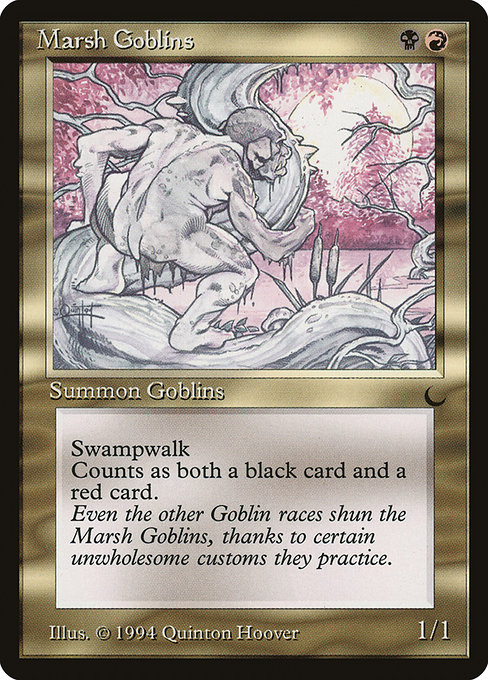
Image courtesy of Scryfall.com
Marsh Goblins and the Metagame Tilt
Two mana, two colors, and a pathway to mischief that can slip through defenses when your opponent isn’t paying attention to their own swamps 🧙♂️🔥. Marsh Goblins is a humble specimen from The Dark (1994) that embodies a recurring MTG truth: utility often hides in the corners. With a mana cost of {B}{R}, this 1/1 Goblin may look modest, but its swampwalk mechanic reveals a deeper design philosophy. When a metagame leans heavily on swamps or lands that create subtle terrain advantages, a small creature with land-specific evasion can become a pressure point that forces players to diversify answers, rather than relying on their usual blocking math. That, in turn, nudges the meta toward faster or differently colored threats, shaping how decks are built and busted open. ⚔️🎲
The Dark was one of MTG’s first bold forays into a darker flavor and harsher economy, and Marsh Goblins stands as a bridge between raw speed and strategic land interaction. The card’s swampwalk—essentially a warning that “your swampy battlefield can matter as much as your hand”—pushes players to think beyond raw power. If your opponent controls a Swamp, Marsh Goblins becomes unblocked by default, turning a quiet two-drop into a strategic headache for black-red barrages that lack reach or light enough removal to keep pace. In formats where swamps dominate or where the mana base isn’t perfectly tuned, a single 1/1 with swampwalk still has teeth. 🧙♂️💎
Card at a glance
- Mana cost: {B}{R}
- Type: Creature — Goblin
- Power/Toughness: 1/1
- Rarity: Common
- Keywords: Swampwalk, Landwalk
- Set: The Dark (DRK), printed 1994
- Flavor text: “Even the other Goblin races shun the Marsh Goblins, thanks to certain unwholesome customs they practice.”
- Artist: Quinton Hoover
In practice, this card invites a layered approach to deck-building. The black-red color identity nods to classic tempo and disruption packages—cards that pressure a fragile mana base, answer threats efficiently, and punish overextension. Marsh Goblins doesn’t win games by sheer force; it wins by forcing opponents to recalibrate what blockers to deploy, which mana sources to rely on, and whether to invest in a swamp-dense defense or a more diverse land mix. For players who love the old-school goblin motif, this little rogue becomes a symbol of how land interactions can tilt outcomes in surprising ways. 🧙♂️🔥
From a design perspective, Marsh Goblins showcases how a creature’s relevance can hinge on the battlefield environment. The late-90s era favored fast, efficient creatures, but The Dark experimented with how terrain could influence combat decisions. Swampwalk, paired with a dual-color cost, creates a scenario where even a 1/1 body can command attention if your opponent’s mana base leans too heavily on Swamps. In a metagame lens, that translates to a demand for flexible answers: removal that hits both colors, early blockers that aren’t easily overwhelmed by the tempo of a two-color assault, and perhaps just enough disruption to keep Marsh Goblins from becoming a pure tempo nuisance. ⚔️💎
Today, Marsh Goblins remains a nostalgic beacon for Legacy, Vintage, and Commander players who relish the goblin archetype or who enjoy throwing a curveball at land-heavy opponents. Its presence in a deck can be a reminder that sometimes the most disruptive plays aren’t the loudest. The card’s value isn’t a spike in power; it’s the prompt it provides for debates about land choice, color identity, and the fragile balance between offense and defense. In a world of complex modern sets, a well-timed swampwalk goblin can still spark laughter and genuine “aha!” moments at the table. 🎨🧙♂️
For collectors and nostalgia enthusiasts, Marsh Goblins is also a window into MTG’s evolving art and flavor. Quinton Hoover’s illustration plus the flavorful line about the Marsh Goblins’ unwholesome customs reminds us of how flavor and mechanics can reinforce each other, inviting players to explore the darker corners of the multiverse. And while it’s a common rarity card, its story—born in a period when the game was redefining itself—still resonates with fans who remember the thrill of building an edge-case, land-aware red-black strategy. 💎
Clear Silicone Phone Case – Slim Durable Open Port DesignMore from our network
- https://blog.crypto-articles.xyz/blog/post/lovense-lush-mini-review-app-controlled-dual-stimulation-vibrator/
- https://crypto-acolytes.xyz/blog/post/nft-stats-blessed-celestios-546-from-blessed-celestio-collection/
- https://crypto-acolytes.xyz/blog/post/nft-stats-777-club-756-from-777-club-collection/
- https://crypto-acolytes.xyz/blog/post/nft-stats-nft-1014-from-useless-unibots-collection/
- https://articles.zero-static.xyz/blog/post/nivix-cyclops-social-media-trends-reshape-mtg-conversation/

Marsh Goblins
Swampwalk (This creature can't be blocked as long as defending player controls a Swamp.)
ID: 8aabd80f-a18a-4bc1-9f05-4c3a63de77ce
Oracle ID: a2c5a504-5c8f-4c1b-a8b1-4e045aee4673
Multiverse IDs: 1821
TCGPlayer ID: 3543
Cardmarket ID: 7399
Colors: B, R
Color Identity: B, R
Keywords: Landwalk, Swampwalk
Rarity: Common
Released: 1994-08-01
Artist: Quinton Hoover
Frame: 1993
Border: black
EDHRec Rank: 28681
Set: The Dark (drk)
Collector #: 93
Legalities
- Standard — not_legal
- Future — not_legal
- Historic — not_legal
- Timeless — not_legal
- Gladiator — not_legal
- Pioneer — not_legal
- Modern — not_legal
- Legacy — legal
- Pauper — legal
- Vintage — legal
- Penny — not_legal
- Commander — legal
- Oathbreaker — legal
- Standardbrawl — not_legal
- Brawl — not_legal
- Alchemy — not_legal
- Paupercommander — legal
- Duel — legal
- Oldschool — legal
- Premodern — not_legal
- Predh — legal
Prices
- USD: 0.32
- EUR: 0.35
More from our network
- https://wiki.digital-vault.xyz/wiki/post/pokemon-tcg-stats-pangoro-card-id-xyp-xy50/
- https://crypto-acolytes.xyz/blog/post/polygon-matic-explained-what-it-is-and-how-it-works/
- https://wiki.digital-vault.xyz/wiki/post/pokemon-tcg-stats-tate-liza-card-id-sm7-148/
- https://crypto-acolytes.xyz/blog/post/nft-stats-solle-106-from-solle-collection/
- https://crypto-acolytes.xyz/blog/post/nft-stats-god-349-from-eternal-gods-collection/